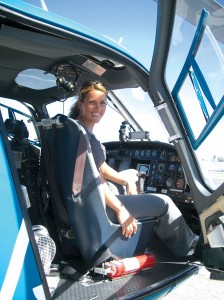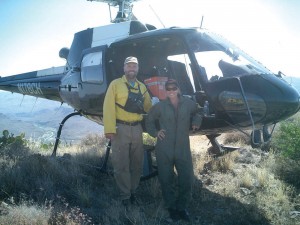By Shirley Lee

Desiree Horton takes a brief timeout from flying over California’s treacherous brushfires while reporting on breaking news for Channel KTLA in Los Angles.
As a little girl, Desiree Horton “wanted to fly like a bird.” Now, she’s a full-fledged helicopter pilot with a wide variety of job experiences to her credit. That includes flying over Los Angeles area freeways to report on traffic and breaking news for an assortment of television channels.
Horton says flying is in her blood. That makes sense, since her deceased father was a pilot. However, he never took her flying, so she never got to share the experience with him.
“He grew up in West Virginia, and flew a Piper Cub back there. Later, he owned a Cherokee. After my parents had my brother and me, they decided he should give up flying,” she explained.
From the moment Horton decided she wanted to be a pilot, she knew her desire was to fly a helicopter. She began taking helicopter lessons at Whiteman Airport in Pacoima when she was 19, but the majority of her training was out of Van Nuys Airport.
“I worked two jobs–one at a car dealership and the other at a pharmacy–to pay for my lessons,” she said. “It took me about two and a half years to get my private license and my commercial one.”
For a while, Horton had her own business, L.A. Copters.
“I rented a helicopter from Scott Reiff, a pilot/reporter known as the Skylord,” she said. “I advertised for tours and photography.”
Later, she did traffic watch for one company and tours for another. In 1998, she started working fulltime for Helinet Aviation at Van Nuys Airport. There, she did everything from covering breaking news assignments to piloting critical medical and organ transport, frost patrol, tours, charter and movie work.
“I have the FAA approved movie manual, which allows me to apply for a waiver to fly below 500 feet and film in off-airport areas, which is generally required for production flying,” she said. “Sometimes I carry a cameraperson aboard and we film the aerial scenes for a particular shoot, or I may be put into wardrobe and sometimes have the helicopter temporarily painted for a scene where a ship is on camera and I’m flying it.”
Among other work, she took part in a scene involving six helicopters for “Showtime,” featuring Robert De Niro and Eddie Murphy.
Reporting news and traffic
For six months of 2005, Horton served as pilot/reporter for the traffic watch portion of KTLA’s morning news. Her weekday schedule was a little overwhelming.
“I would get up at about 3 a.m. to give myself time to get ready and leave for work,” she said. “I was at the airport by 4:30. Sometimes I didn’t get out of there until 3 or 4 o’clock in the afternoon.”
Two pilots covered the KTLA helicopter for the entire day, which ended with the 10 o’clock news.
“My off time was supposed to be 1:30 p.m., but if there was a pursuit or a fire or any type of news story that happened before my relief pilot got there, I was stuck there for several hours. We would go anywhere to cover a story–even as far as San Diego or Santa Maria.”
Horton said she loved that job, but that it was mentally tiring.
“There were several radios I would listen to at the same time in my headset,” she said. “If I was in air space, I’d be talking to air traffic control. Then I had an air-to-air frequency with the other helicopters that might be in my same area, working the story with me. Sometimes the tower would constantly talk to me while I was trying to copy traffic information, listen to the producer, talk to the producer, the assignment desk, my cameraman and the anchors.”

R to L: Desiree Horton poses with Don Sharlow, helicopter manager of the Cave Creek Complex fire, near Carefree, Ariz. The fire covered more than 150,000 acres in Arizona.
At the same time, other pilots would be talking to her, letting her know what position they were at next to her.
“All the while I had to acknowledge each person who was talking to me, from all these radios, set the helicopter in a good position for the shot and still keep a safe distance from other news and traffic helicopters,” she said. “Occasionally, I would even monitor the police scanner to pick up additional information about a story. Don’t forget, I had to report on live TV as well! There was a lot going on in my head. Thankfully, flying the helicopter was second nature and I didn’t have to think about flying; my hands and feet just controlled the aircraft without thought.”
Sometimes she would listen to transmission–the frequency that the cameraman in the back seat used to talk to the people at the station to establish signals. That was so she would know when they were “powered up,” when they were live on camera, or when they were going to be used for a “bump shot.” That was a “going-to-commercial” type shot that showed something pretty or interesting that they were flying over.
“At the same time, I had to listen to the anchors, because when they were talking, they might try to include me,” she explained. “I also might be writing down traffic information while I was flying. Sometimes we needed to look up locations in the Thomas Guide, when the assignment desk sent us to breaking news.”
Even though the cameraman opened the book and found the page, Horton had to look at it also, because she was the one flying there. Since the cameraman sat in the back seat, she had to adjust the inside talent camera in the front that was directed on her, as the light changed, as well. For the first two hours, there was a traffic report every five to 10 minutes.
“I had to coordinate pulling up on scenes, letting the tower know where I was, talking to the other helicopters, and talking to the producer,” she said. “When the anchors talked to me, I would hope that air traffic control didn’t interrupt while I was giving my report.”
Horton is glad that the above job has ended. That channel went back to using a helicopter pilot and a reporter as a simpler way of handling the situation. Prior to her hiring, in April 2005, her job at KTLA/WB had been filled by two people–a pilot and a reporter–with a cameraman as well.
Now–besides doing freelance flying jobs for the breaking news of most of the television channels in the area, she plans to concentrate on her true love, which is firefighting.
Firing up for fires
For fun, in her spare time, Horton snowboards, surfs, rides motorcycles and fights fires. She received her certification to fight fires aerially for the U.S. Forest Service at the end of the summer of 2004.
“I’d always wanted to fight fires, but before I went to Channel 5, I was working for Channel 7, so I had never pursued my real passion,” she said. “Instead, I was distracted by the fact that I was being paid extra for both flying the helicopter and reporting. At the time I received my card from the U.S. Forest Service last year, there weren’t any fires to send me out on, as it was the end of the fire season. But this year, I’ve already gone out on two fires.”
While still working on her traffic reporting job, she would go out on a Friday night and then come back on a Sunday evening.
“I went to one fire in Arizona and one in Oregon,” she said. “Both times it was so rewarding. The missions included dropping water, Helco, air-attack, troop transport, flying the perimeter of the fire to get the exact outline for mapping and equipment shuttle. Sometimes I would fly the crews up to the higher mountains to put up the repeaters for the radio communication on the fire. Each mission had an important purpose. Helco is the helicopter coordinator of all the water-dropping helicopters on the fire. Air-attack would coordinate all aircraft, including the tanker planes.”
Explaining the water drop, she said, “My crew hooks up the bucket; then I’m on my own. I go out to a dip site to get the water, go to the fire and hit the button to drop it. My helicopter can’t carry too much water, so it’s literally like spitting on the fire.”
Since every fire is different, the altitude one needs to fly varies.
“You don’t want to get too low, but you don’t want the water to dissipate too much before it hits the ground either,” she said. “So far, I haven’t been frightened. I’ve just been excited.”
Horton recalled that a motion picture that made a special impression on her was “Always,” with Richard Dreyfuss, John Goodman, and Holly Hunter.
“It’s about aerial fire fighting, and I find the scenes amazing,” she said.
During her last two weeks at KTLA, at the time of the recent serious fires in the western part of California’s San Fernando Valley, she was called upon to fly over the area and report on its progress for television. Currently working freelance for Helinet Aviation, Coastal Helicopters and Angel City Air, Desiree Horton hopes to sign a contract with one of the private companies that supplies helicopters to do firefighting assignments and make that her major regular job.
“Even better, my ultimate dream job is to fly a helicopter for the Los Angeles County or Los Angeles City Fire Department,” she said.











